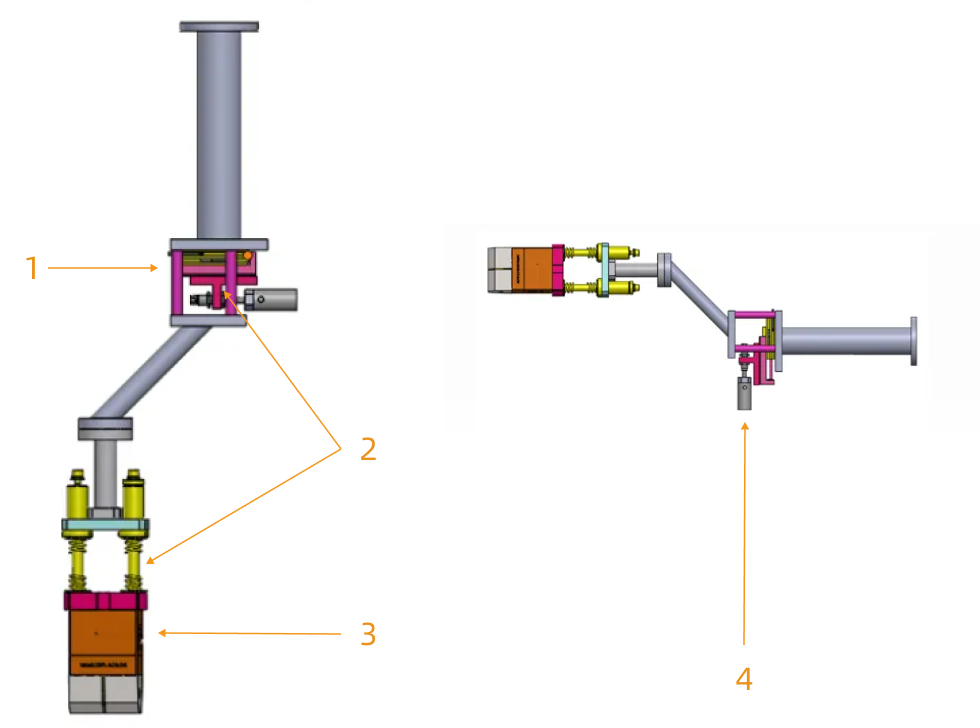Solution Design
This section introduces the solution design of the Small Metal Parts in Deep Bin solution, including the workflow of the vision system, software combination, camera model selection, and calibration board selection.
Workflow of the Vision System
The workflow of the vision system is shown in the figure below.

This solution needs to be implemented in two steps:
-
First, recognize small metal parts in the deep bin, and then pick some metal parts and place them on the repositioning station. This corresponds to the Small Metal Parts in Deep Bin project in Mech-Vision.
-
Second, recognize the metal parts on the repositioning station, and then pick and place them on the centering station. This corresponds to the Small Metal Parts on Repositioning Station project in Mech-Vision.
After configuring the visual recognition project, you can run the modified robot picking program to guide the robot to pick randomly and accurately from a deep bin filled with small parts, automating the material supply.
Software Combination
This solution uses Mech-Vision to recognize the poses of small metal parts in the deep bin and uses Mech-Viz to plan the path for picking.
As shown below, Mech-Viz plans a robot picking path based on the pose and returns it to an external device (such as a robot, PLC, etc.) through Standard Interface communication.

Select Camera and Determine Mounting Height
For loading small metal parts in the deep bin, Mech-Eye PRO S-GL Industrial 3D Camera (hereinafter referred to as PRO S-GL) and Mech-Eye PRO M-GL Industrial 3D Camera (hereinafter referred to as PRO M-GL) are recommended, based on the camera’s field of view, accuracy and working distance. The cameras have high accuracy, fast speed, and excellent resistance to ambient light. For detailed technical specifications of these two cameras, please refer to PRO Series Technical Specifications. If you need to use a camera of other models, please use the 3D Camera Selector to select the appropriate model.
After determining the camera model, please use the 3D Camera Selector to determine the mounting height of the camera. Follow the steps below:
-
Determine the dimensions of the objects on the top layer and the possible maximum height, and fill in the Length, Width, and Height in the Object dimensions panel.
To accommodate deviations in the position of the incoming objects, a margin of 150–200 mm should be left on each side of the top layer, as shown below. Namely, the length and height values should equal the dimensions of the top layer of the objects plus the reserved margin shown in the figure below.

-
Turn on the switch to the right of Distance from camera to object and keep adjusting the parameter value until the square on the right that represents the object is at the center of the camera FOV and is completely covered, i.e., the square becomes green.

-
Mounting height = Distance from camera to object + object height
To ensure good data quality, the distance from the camera to the top layer of the object should be within the recommended working distance, provided that the requirements of the FOV and robot workspace are met.
Select Calibration Board
-
PRO S-GL
-
When the working distance is 500–800 mm, the recommended calibration board model is CGB-020.
-
When the working distance is 800–1000 mm, the recommended calibration board model is CGB-035.
-
-
PRO M-GL
-
When the working distance is 1000–1500 mm, the recommended calibration board model is CGB-035.
-
When the working distance is 1500–2000 mm, the recommended calibration board model is CGB-050.
-
Select IPC Model
The recommended IPC is Mech-Mind IPC STD, which is suitable for regular depalletizing and loading scenarios.
Select Robot Model
To pick small metal parts, a high-accuracy six-axis robot should be selected according to the picking range and accuracy requirements. The FANUC_M_10ID_12 robot is used as an example in this solution.
For robots of other brands, please refer to Robot Model Selection.
Workstation Layout Design
The layout of the on-site workstation is shown in the figure below. The PRO M-GLcamera is mounted 2 meters directly above the bin. After capturing the image, the camera can acquire the point clouds of the bin and all target objects in it. The PRO S-GLcamera is mounted 1 meter directly above the repositioning station. After capturing the image, the camera can acquire the point clouds of all target objects on the repositioning station. The items in the figure are: 1-PRO M-GL camera; 2-camera mounting frame; 3-robot; 4-infeed bin; 5-PRO S-GL camera; 6-electrical cabinet; 7-robot tool; 8-robot controller; 9-temporary bin; 10-centering station; 11-repositioning station.

Robot Tool Design
The gripper used in this solution is shown in the figure below. The items in the figure are: 1-pneumatic cylinder; 2-buffer; 3-gas-controlled permanent magnet; 4-electromagnet. The gas-controlled permanent magnet is used to pick small metal parts from the bin, and the gripper configuration is shown on the left. The electromagnet is used to pick small metal parts from the repositioning station, and the gripper configuration is shown on the right.
